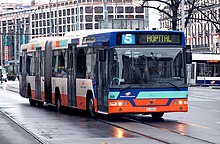Volvo 7000
| Volvo | |
|---|---|

Volvo 7000 |
|
| 7000, 7000A articulated bus | |
| Manufacturer | Volvo trucks |
| design type |
City bus public service bus |
| Production period | 1998-2003 |
| axes | 2 3 |
| engine | 6-cylinder diesel engine Volvo D7C |
| power | 215–250 hp 250–310 hp (articulated bus) |
| length | 11,944 mm (7000) 17,944 mm (7000A) w |
| width | 2500-2550 mm |
| height | 3050 mm |
| Wheelbase | 5945 mm (7000) 5190 + 6755 mm (7000A) mm |
| Seats | 36 (7000) 42 (7000A) |
| Standing room | 54 (7000) 133 (7000A) |
| Empty weight | 10,600 kg (7000) 15,660 (7000A) kg |
| Perm. total weight | 18,000 kg (7000) 28,000 (7000A) kg |
| successor | Volvo 7700 |
The Volvo 7000 was a city bus that Volvo produced between 1998 and 2003. It was the result of a collaboration between Volvo and the Finnish coachbuilder Carrus Oy . The body corresponded to the Carrus type K206 and the chassis to the Volvo B7L , which was produced in Poland . In addition to production at Carrus in Turku in Finland, the Volvo 7000 was also produced in Wroclaw , Poland, from 1999 . In addition to the standard variant , there was the articulated bus 7000A. In 2003, the Volvo 7700 replaced the series, which was hardly changed at first, but is only produced in Poland.
Technical specifications
The Volvo 7000 series was powered by the Volvo D7C diesel engine with an output of 158 or 184 kW, coupled with a ZF -5HP502-N automatic transmission. They were available with two and three passenger doors. The engine was mounted vertically at the rear left.
Shortly after the launch of the Volvo 7000, the Volvo 7000A articulated bus followed . The articulated bus had an increased engine output of 184, 202 or 228 kW and had three or four passenger doors.
In addition to the diesel version, there were LPG and CNG versions. These versions had the tank at the top of the front on the roof.

